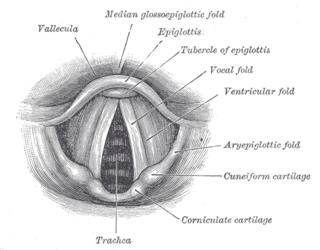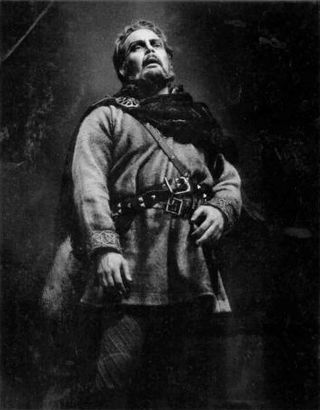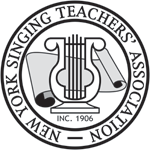
Singing is the act of creating musical sounds with the voice. A person whose profession is singing is called a singer, artist or vocalist. Singers perform music that can be sung with or without accompaniment by musical instruments. Singing is often done in an ensemble of musicians, such as a choir. Singers may perform as soloists or accompanied by anything from a single instrument up to a symphony orchestra or big band. Different singing styles include art music such as opera and Chinese opera, Indian music, Greek music, Japanese music, and religious music styles such as gospel, traditional music styles, world music, jazz, blues, ghazal, and popular music styles such as pop, rock, and electronic dance music.
Falsetto is the vocal register occupying the frequency range just above the modal voice register and overlapping with it by approximately one octave.
Vocal range is the range of pitches that a human voice can phonate. A common application is within the context of singing, where it is used as a defining characteristic for classifying singing voices into voice types. It is also a topic of study within linguistics, phonetics, and speech-language pathology, particularly in relation to the study of tonal languages and certain types of vocal disorders, although it has little practical application in terms of speech.

David Conte is an American composer who has written over 150 works published by E.C. Schirmer, including six operas, a musical, works for chorus, solo voice, orchestra, chamber music, organ, piano, guitar, and harp. Conte has received commissions from Chanticleer, the San Francisco Symphony Chorus, Harvard University Chorus, the Men’s Glee Clubs of Cornell University and the University of Notre Dame, GALA Choruses from the cities of San Francisco, New York, Boston, Atlanta, Seattle, and Washington, D.C., the Dayton Philharmonic, the Oakland Symphony, the Stockton Symphony, the Atlantic Classical Orchestra, the American Guild of Organists, Sonoma City Opera, and the Gerbode Foundation. He was honored with the American Choral Directors Association (ACDA) Brock Commission in 2007 for his work The Nine Muses, and in 2016 he won the National Association of Teachers of Singing (NATS) Art Song Composition Award for his work American Death Ballads.

A vocal register is a range of tones in the human voice produced by a particular vibratory pattern of the vocal folds. These registers include modal voice, vocal fry, falsetto, and the whistle register. Registers originate in laryngeal function. They occur because the vocal folds are capable of producing several different vibratory patterns. Each of these vibratory patterns appears within a particular range of pitches and produces certain characteristic sounds.
Matthew Hoch is an American academic and teacher of singing.
The National Association of Teachers of Singing (NATS) is a professional organization for singing teachers, and it is the largest association of its kind in the world. There are more than 6,500 members, mostly from the United States. Additional members are from Canada and over twenty-five other countries around the world including: Australia, Austria, Brazil, China, Costa Rica, Denmark, Egypt, France, Germany, Iceland, Italy, Japan, Jordan, Korea, Malaysia, Mexico, Netherlands, New Zealand, Singapore, South Africa, South Korea, Spain, Switzerland, Taiwan, United Arab Emirates, and the United Kingdom.
A voice type is a group of voices with similar vocal ranges, capable of singing in a similar tessitura, and with similar vocal transition points (passaggi). Voice classification is most strongly associated with European classical music, though it, and the terms it utilizes, are used in other styles of music as well.

Vocal pedagogy is the study of the art and science of voice instruction. It is used in the teaching of singing and assists in defining what singing is, how singing works, and how proper singing technique is accomplished.
A voice teacher or singing teacher is a musical instructor who assists adults and children in the development of their abilities in singing.
William Vennard was a famous American vocal pedagogist who devoted his life to researching the human voice and its use in singing. He was one of the driving forces behind a major shift within the field of vocal pedagogy during the middle of the 20th century.
Vocal resonance may be defined as "the process by which the basic product of phonation is enhanced in timbre and/or intensity by the air-filled cavities through which it passes on its way to the outside air." Throughout the vocal literature, various terms related to resonation are used, including: amplification, filtering, enrichment, enlargement, improvement, intensification, and prolongation. Acoustic authorities would question many of these terms from a strictly scientific perspective. However, the main point to be drawn from these terms by a singer or speaker is that the result of resonation is to make a better sound, or at least suitable to a certain esthetical and practical domain.

Cornelius Lawrence Reid, was a well-known vocal pedagogue in New York City, specialist in the bel canto technique, and author of books on bel canto.

Joseph Shore was an American operatic Baritone and voice teacher. He has excelled particularly in the operas of Giuseppe Verdi.
Dunedin Academic Press Ltd (Dunedin) is a small independent academic publisher in Edinburgh, Scotland which publishes mainly books for the tertiary (undergraduate) level and periodically for postgraduate/research audiences. It has a London office as well. Dunedin also publishes books appealing to non-specialist adults interested in learning more about geology. Graham Park's Introducing Geology, now in its Second Edition, is a notable example. Dunedin's Introducing Earth and Environmental Sciences series, of which Introducing Geology was the first title now contains books covering topics in Astronomy, Meteorology and Oceanography as well as a lengthening list of geology and other earth science topics. "The Abyss of Time" by Paul Lyle won the Association for Science Education Book of the Year award in 2017.
Rosephanye Powell, pronounced ro-SEH-fuh-nee, is an American choral composer, singer, professor, and researcher.

The Complete Vocal Institute (CVI) is a private educational institution located in Copenhagen, Denmark. The Institute specialises in the theoretical basis and practical application of the Complete Vocal Technique, a technique developed by singer and voice researcher Cathrine Sadolin. Formed in 2005, the Complete Vocal Institute is today one of the largest singing and vocal institutes in Europe, with 528 authorised teachers and thousands of graduates from over 30 nations across the world.
Wanda Brister is an American operatic mezzo-soprano and voice teacher.
Patricia Caicedo is a Colombian-Spanish classical soprano and musicologist who specializes in the study and performance of the Latin American and Spanish art song repertoire in Spanish, Catalan, Portuguese and Indigenous languages. She is also a trained physician.

The New York Singing Teachers' Association (NYSTA) is an international educational association of singing teachers and affiliated voice professionals based in New York City. It was founded in 1906, and is the oldest such group based in the United States. The association provides worldwide training in the teaching of singing through local events, as well as educational media archives and a highly regarded professional development program available to members worldwide via its website, www.nyst.org








